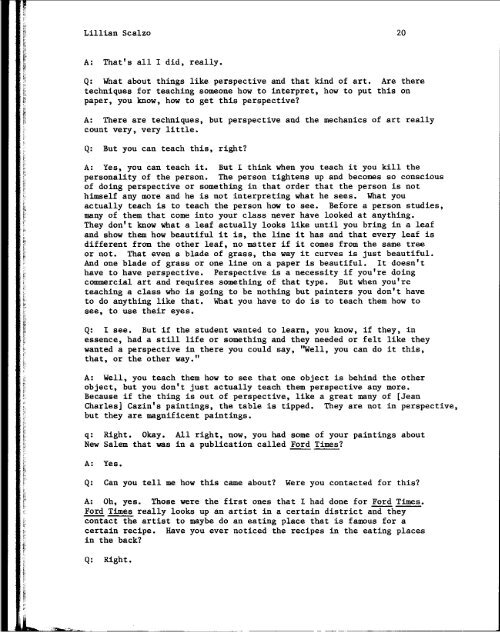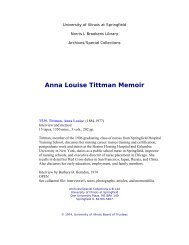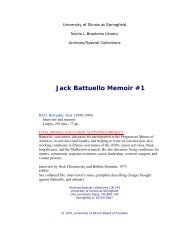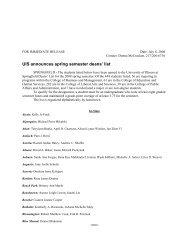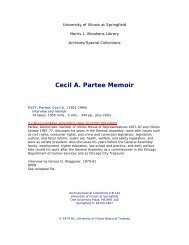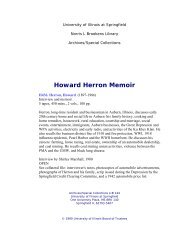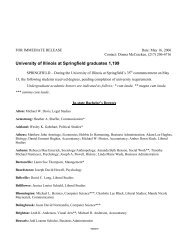Lillian Scalzo Memoir - University of Illinois Springfield
Lillian Scalzo Memoir - University of Illinois Springfield
Lillian Scalzo Memoir - University of Illinois Springfield
Create successful ePaper yourself
Turn your PDF publications into a flip-book with our unique Google optimized e-Paper software.
<strong>Lillian</strong> <strong>Scalzo</strong> 20<br />
A: That's all I did, really.<br />
Q: What about things like perspective and that kind <strong>of</strong> art. Are there<br />
techniques for teaching someone how to interpret, how to put this on<br />
paper, you know, how to get this perspective?<br />
A: There are techniques, but perspective and the mechanics <strong>of</strong> art really<br />
count very, very little.<br />
Q: But you can teach this, right?<br />
A: Yes, you can teach it. But I think when you teach it you kill the<br />
personality <strong>of</strong> the person. The person tightens up and becomes so conscious<br />
<strong>of</strong> doing perspective or something in that order that the person is not<br />
himself any more and he is not interpreting what he sees. What you<br />
actually teach is to teach the person how to see. Before a person studies,<br />
many <strong>of</strong> them that come into your class never have looked at anything.<br />
They don't know what a leaf actually looks like until you bring in a leaf<br />
and show them how beautiful it is, the line it has and that every leaf is<br />
different from the other leaf, no matter if it comes from the same tree<br />
or not. That even a blade <strong>of</strong> grass, the way it curves is just beautiful.<br />
And one blade <strong>of</strong> grass or one line on a paper is beautiful. It doesn't<br />
have to have perspective. Perspective is a necessity if you're doing<br />
commercial art and requires something <strong>of</strong> that type. But when you're<br />
teaching a class who is going to be nothing but painters you don't have<br />
to do anything like that. What you have to do is to teach them how to<br />
see, to use their eyes.<br />
Q: I see. But if the student wanted to learn, you know, if they, in<br />
essence, had a still life or something and they needed or felt like they<br />
wanted a perspective in there you could say, "Well, you can do it this,<br />
that, or the other way."<br />
A: Well, you teach them how to see that one object is behind the other<br />
object, but you don't just actually teach them perspective any more.<br />
Because if the thing is out <strong>of</strong> perspective, like a great many <strong>of</strong> [Jean<br />
Charles] ~azin's paintings, the table is tipped. They are not in perspective,<br />
but they are magnificent paintings.<br />
q: Right. Okay. All right, now, you had some <strong>of</strong> your paintings about<br />
New Salem that was in a publication called Ford Times? --<br />
A: Yes.<br />
Q: Can you tell me how this came about? Were you contacted for this?<br />
--<br />
A: Oh, yes. Those were the first ones that I had done for Ford Times.<br />
--<br />
Ford Times really looks up an artist in a certain district and they<br />
contact the artist to maybe do an eating place that is famous for a<br />
certain recipe. Have you ever noticed the recipes in the eating places<br />
in the back?<br />
Q: Right.


